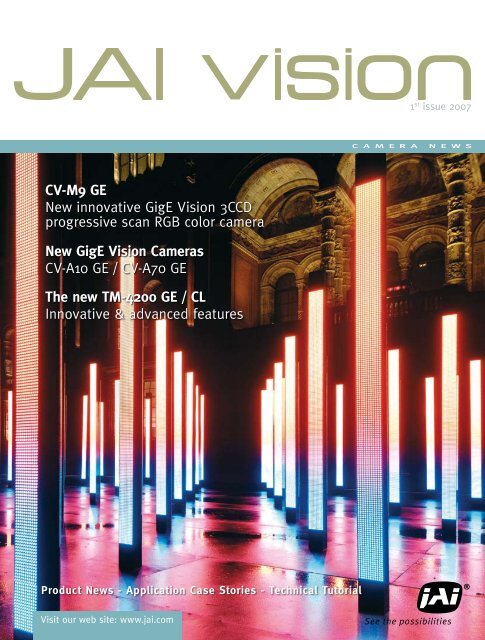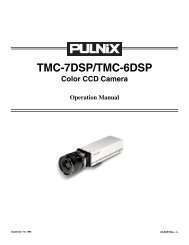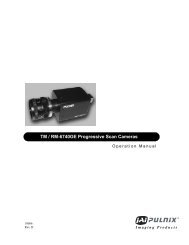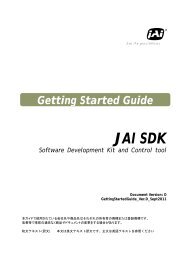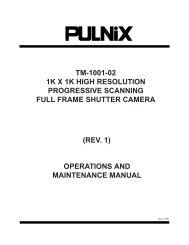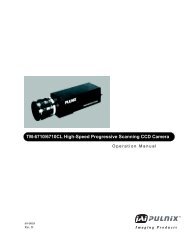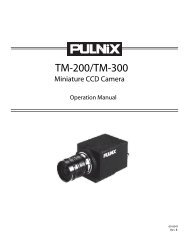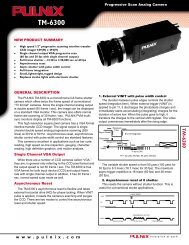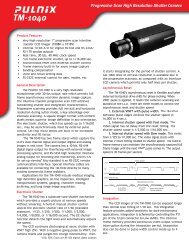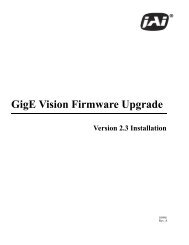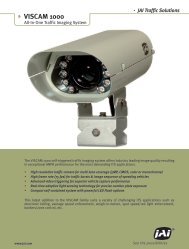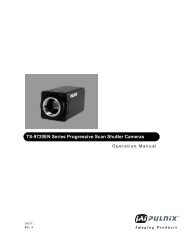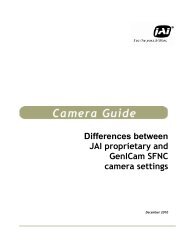New GigE Vision Cameras - JAI Pulnix
New GigE Vision Cameras - JAI Pulnix
New GigE Vision Cameras - JAI Pulnix
- TAGS
- gige
- vision
- cameras
- pulnix
- www.jai.com
You also want an ePaper? Increase the reach of your titles
YUMPU automatically turns print PDFs into web optimized ePapers that Google loves.
CV-M9 GE<br />
<strong>New</strong> innovative <strong>GigE</strong> <strong>Vision</strong> 3CCD<br />
progressive scan RGB color camera<br />
<strong>New</strong> <strong>GigE</strong> <strong>Vision</strong> <strong>Cameras</strong><br />
CV-A10 GE / CV-A70 GE<br />
The new TM-4200 GE / CL<br />
Innovative & advanced features<br />
Product <strong>New</strong>s - Application Case Stories - Technical Tutorial<br />
Visit our web site: www.jai.com<br />
1 st issue 2007<br />
c a m e r a n e w s
<strong>JAI</strong> update<br />
<strong>JAI</strong> <strong>Vision</strong> <strong>New</strong>s<br />
“WHERE CAMERAS ARE A PASSION”<br />
Welcome to the spring edition of <strong>JAI</strong> <strong>Vision</strong> Camera <strong>New</strong>s, which features a range of<br />
important product launches and application stories from <strong>JAI</strong>.<br />
By now practically everyone knows about Gigabit Ethernet for machine vision and industrial imaging – and<br />
credit has to be given to the Automated Imaging Association (AIA) and key industrial players in establishing a<br />
coherent standard for finally getting the camera on the network. The standard provides safe transmission of<br />
high data rates, including simplification of connectivity and affordability in building vision applications.<br />
<strong>JAI</strong> has supported and embraced this technological evolution right from the start, and we intend to stay at<br />
the forefront of our industry. As you can read in this edition – we are introducing more new hardware with<br />
additional features around this new important standard. The way forward for <strong>JAI</strong> continues to be strict focus<br />
on customer needs and new product development.<br />
Also in this edition of <strong>JAI</strong> <strong>Vision</strong>: – <strong>JAI</strong> camera technology wows Londoners, news on <strong>JAI</strong> corporate branding,<br />
new applications with <strong>GigE</strong> networking, channel update for the US market and new features in the dual-tap<br />
cameras.<br />
Given a maybe mixed weather outlook and significant changes to the vision market – we continue to meet<br />
new opportunities in all regions - with Asia being the most vibrant.<br />
We hope you continue to enjoy the magazine – every step we take is headed towards more value for our<br />
customers.<br />
Please feel free to give us your comments and feedback.<br />
Henrik Ilsby<br />
Senior VP, <strong>JAI</strong> Camera Solutions<br />
upcoming imaging events 2007<br />
June 6 - 8, 2007<br />
Exhibition on Sensing via<br />
Image Information<br />
Yokohama, Japan<br />
www.seiki-tsushin.com/sensing/eng/<br />
<strong>JAI</strong> Camera Solutions<br />
June 12 - 14, 2007<br />
Robots & <strong>Vision</strong> 2007<br />
Rosemont, Chicago, IL, USA<br />
www.robots-vision-show.info<br />
<strong>JAI</strong> Camera Solutions<br />
2<br />
June 15 – 16, 2007<br />
5th European Machine <strong>Vision</strong> Business Conference<br />
Lyon, France<br />
www.emva.org<br />
<strong>JAI</strong> Camera Solutions<br />
November 6 – 8, 2007<br />
<strong>Vision</strong> 2007<br />
www.vision-messe.de<br />
Stuttgart, Germany<br />
<strong>JAI</strong> Camera Solutions
application case story<br />
Advanced vision technology wows Londoners<br />
“This is absolutely stunning. Kudos to the designers,” said one.<br />
“WOW, this deserves to be permanent” said another. The object<br />
of their admiration was ‘Volume’, a luminous interactive installation<br />
which attracted Londoners in their thousands to the John<br />
Madejski Garden of the V&A Museum in South Kensington from<br />
November 2006 to January 2007.<br />
Brilliant display<br />
‘Volume’ was the result of a collaboration between Londonbased<br />
lighting designers United Visual Artists and Robert Del<br />
Naja of Massive Attack and his co-writer Neil Davidge (as part<br />
of their music production company, one point six). The walk-in<br />
installation featured an array of light columns that responded<br />
spectacularly to human movement, triggering a brilliant display<br />
of light and sound.<br />
Visitors curious to know how their motion was being detected<br />
would probably have noticed a row of infra-red illuminators<br />
mounted on a first floor balcony, but what was really tracking<br />
their movement was sitting in the shadows of an alcove above<br />
1. Edition 2007<br />
- a <strong>JAI</strong> TM-1325 CL camera, supplied by <strong>JAI</strong>’s UK distributor<br />
Firstsight <strong>Vision</strong>, which is UK & Ireland’s largest independent<br />
supplier of machine vision components including cameras,<br />
optics, interfaces, software and smart systems.<br />
Ideal solution<br />
The <strong>JAI</strong> TM-1325 CL infra-red camera<br />
tracking people’s movements.<br />
Firstsight <strong>Vision</strong>’s Business Development Manager Alastair<br />
Slater describes why the camera provided an ideal solution for<br />
the ‘Volume’ installation: “The system was designed to work<br />
by reflecting near infra-red light from the scene to a suitably<br />
sensitive camera with sufficient resolution and frame rate. The<br />
<strong>JAI</strong> TM-1325 CL is a 1.45 megapixel camera with enhanced near<br />
IR response and a frame rate of 30 Hz, so it was more than up<br />
to the job.”<br />
For the installation, the camera was equipped with a filter to<br />
block all ambient illumination. Since the light columns were<br />
static, the only variation in light reflection would come from<br />
people moving on the scene. The signal from the camera could<br />
then be processed to detect the location of movement and trigger<br />
the emission of light and sound from each column in relation<br />
to the proximity of movement. ‘Volume’ used components from<br />
the Common <strong>Vision</strong> Blox image processing library, for which<br />
Firstsight <strong>Vision</strong> is also the UK supplier.<br />
Alastair Slater concedes that camera applications of this type<br />
are limited, but he acknowledges that they certainly provide a<br />
colorful and entertaining means of demonstrating what cameras<br />
like the <strong>JAI</strong> TM-1325 CL can do.<br />
<strong>JAI</strong> <strong>Vision</strong> <strong>New</strong>s<br />
3
Question Answer<br />
What is the maximum cable length of a Gigabit Ethernet<br />
connection?<br />
Cable lengths of up to 100 meters are possible. Longer distances can be<br />
bridged using switches or routers.<br />
What type of cable is required for <strong>GigE</strong> <strong>Vision</strong> cameras? Cat5e can be used, but Cat 6 is recommended.<br />
How can I avoid trigger latency with <strong>GigE</strong> <strong>Vision</strong> cameras? All <strong>JAI</strong> <strong>GigE</strong> <strong>Vision</strong> cameras accept a hardware trigger (in the 12-pin Hirose<br />
How many cameras can I connect to one <strong>GigE</strong> <strong>Vision</strong><br />
host?<br />
Technical tutorial<br />
FAQ’s - <strong>GigE</strong> <strong>Vision</strong> Standard Interface<br />
Which Gigabit Ethernet devices can I use together with<br />
the <strong>GigE</strong> <strong>Vision</strong> cameras?<br />
connector), providing no-delay triggering.<br />
In theory, <strong>GigE</strong> <strong>Vision</strong> allows an infinite number of cameras to be connected.<br />
In practice, however, the number of cameras depends on the transmission<br />
rate (MByte/sec) being sent from each camera; Image resolution x frame rate<br />
= transmission rate. The maximum transmission bandwidth is 110 Mbyte/sec.<br />
All network switches designed for Gigabit Ethernet can be used. When using<br />
Jumbo packets, make sure to use a switch that can handle more than 1.5kB<br />
packets.<br />
What is a Jumbo packet? An Ethernet data packet larger than 1440 kBytes is loosely referred to as a<br />
Jumbo packet. Using Jumbo packets improves the transmission throughput,<br />
as the overhead (packet headers) is reduced.<br />
Does <strong>JAI</strong> provide software with the cameras? Yes, <strong>JAI</strong> provides the necessary drivers and other DLL files for WinXP. There<br />
is also an SDK (Software Developent Kit) for the cameras, allowing the<br />
system engineer to easily integrate the cameras in the application.<br />
What is GenICam? GenICam is a standard associated with the <strong>GigE</strong> <strong>Vision</strong> standard, defining a<br />
generic interface for controlling cameras in conjunction with an XML file.<br />
What is an XML file? It is a standard file format used to describe the functions available to a<br />
<strong>JAI</strong> <strong>Vision</strong> <strong>New</strong>s<br />
4<br />
particular camera. The XML file resides in the camera and is downloaded to<br />
the host when the camera is connected. The host software is then automati-<br />
cally configured with the functions (and range of settings of the functions)<br />
for precisely this camera.
Application<br />
<strong>New</strong> applications with <strong>GigE</strong> <strong>Vision</strong> networking<br />
An increasing number of <strong>JAI</strong>’s customers with knowledge of network topology are now using and<br />
evaluating <strong>JAI</strong>’s <strong>GigE</strong> <strong>Vision</strong> cameras, in a range of new types of imaging applications. Many of<br />
these new applications have not been possible before, at least not at an acceptable price level.<br />
Concrete crack propagation<br />
One application example can be found in the field of stress<br />
testing of building elements where there is a need to monitor<br />
structural crack propagation as real life building elements are<br />
collapsed under controlled pressure. As the building elements<br />
under test have a significant size, it would require multiple<br />
cameras set up in a network configuration.<br />
This could be a set-up of between 15 and 20 cameras around a<br />
full size concrete dome structure with the aim of mapping and<br />
documenting a stress test from all angles of the dome structure<br />
just before and during the collapse. Using a star network topology<br />
configuration with cables up to 100 meters long, it is possible<br />
in this example to use 4 PCs each getting 12 synchronized<br />
frames per second from multiple 1920 x 1080 pixel cameras.<br />
Example of star network topology<br />
High-end surveillance<br />
Another example where <strong>JAI</strong>’s <strong>GigE</strong> <strong>Vision</strong> camera technology is<br />
ideal in Ethernet configurations is in high-end surveillance systems<br />
e.g. airport security systems. One operator would be able<br />
to monitor 12 XGA or 30 VGA cameras at 10 fps simultaneously<br />
from the same network string while another security operator in<br />
a completely different location at the airport, would be able to<br />
monitor the same cameras at the same time, or even a completely<br />
different set of cameras. Applying Ethernet network configuration<br />
together with <strong>JAI</strong>’s high resolution cameras provides maximum<br />
flexibility in any kind of high-end surveillance application.<br />
Frame buffering<br />
1. Edition 2007<br />
<strong>JAI</strong>’s <strong>GigE</strong> <strong>Vision</strong> cameras feature built-in frame buffers where<br />
image frames can be stored until the application software<br />
is ready to retrieve them. This feature is especially useful in<br />
applications where there is a need to capture a large amount of<br />
images from multiple cameras in a network during a very short<br />
time frame.<br />
An application example could be capturing images of train<br />
wheels in motion as the trains pass by at full speed. The images<br />
are captured almost simultaneously and stored in the camera<br />
buffer. When the train has passed, the images are transferred<br />
from the camera buffer to the application software at the speed<br />
the software is ready to retrieve them. This scenario would only<br />
require a single computer.<br />
Round-robin technique for heavy image processing<br />
Heavy image processing<br />
In cases where heavy image processing is needed, multiple<br />
processors can be put to work using a round-robin technique.<br />
Using <strong>JAI</strong> <strong>GigE</strong> <strong>Vision</strong> cameras in networks is opening up a range<br />
of new and advanced imaging applications. If you would like to<br />
discuss these exciting new possibilities, please contact <strong>JAI</strong> or<br />
your local <strong>JAI</strong> distribution partner.<br />
<strong>JAI</strong> <strong>Vision</strong> <strong>New</strong>s<br />
5
product news<br />
<strong>New</strong> innovative 3CCD progressive scan RGB color camera<br />
featuring <strong>GigE</strong> <strong>Vision</strong> interface<br />
<strong>JAI</strong> introduces the CV-M9GE - a new innovative digital 3CCD industrial<br />
progressive scan RGB color camera. With the CV-M9GE, machine vision<br />
integrators and machine vision users for the first time have access to an<br />
industrial camera that combines advanced 3CCD RGB color vision technology<br />
with the easy-to-use <strong>GigE</strong> <strong>Vision</strong> standard interface.<br />
The design of the CV-M9GE is based on<br />
<strong>JAI</strong>’s popular and proven 3CCD CV-M9CL<br />
camera which is widely used in demanding<br />
machine vision applications across a<br />
diverse range of industries. The CV-M9GE<br />
is suitable for use in semiconductor production,<br />
food sorting, print inspection and<br />
flat panel quality verification, as well as in<br />
medical devices for patient diagnostics.<br />
CV-M9 GE highlights<br />
• 3CCD progressive scan<br />
• <strong>GigE</strong> <strong>Vision</strong> interface<br />
• 1024 x 768 pixels per color<br />
• 30 frames/second<br />
• Programmable GPIO<br />
The <strong>GigE</strong> <strong>Vision</strong> standard interface,<br />
together with programmable GPIO<br />
(General Purpose Input/Output) ports<br />
used in the CV-M9GE, takes the trouble<br />
out of integrating advanced 3CCD prism<br />
color technology into even the most<br />
demanding imaging applications.<br />
<strong>JAI</strong> <strong>Vision</strong> <strong>New</strong>s<br />
6<br />
<strong>GigE</strong> <strong>Vision</strong> cameras use standard<br />
Cat5e or Cat6 cabling<br />
and do not require a dedicated<br />
frame grabber in the<br />
PC. This translates directly<br />
into cost savings and shorter<br />
“time-to-market” when developing<br />
advanced machine vision inspection<br />
systems.<br />
Based on 3CCD prism technology, the<br />
CV-M9GE provides full XGA (1024 x 768)<br />
resolution for each of the Red, Green and<br />
Blue color bands. The camera features<br />
both manual and automatic one-push<br />
white balance adjustment, making it easy<br />
to achieve the correct setting for a wide<br />
range of color temperatures and under<br />
difficult lighting conditions. Alternatively<br />
the white balance can be adjusted by individual<br />
shutter settings in the Red, Green<br />
and Blue channels, while maintaining a<br />
consistent and high signal/noise ratio in<br />
each channel.<br />
The CV-M9GE can be operated in continuous<br />
(free-run) mode at 30 frames/<br />
second or in external trigger mode.<br />
CV-M9GE - The first 3CCD camera with <strong>GigE</strong> <strong>Vision</strong> interface<br />
The Edge Pre-Select trigger mode uses a<br />
pre-defined exposure time whereas the<br />
Pulse Width Control trigger mode sets the<br />
exposure time based on the width of the<br />
trigger pulse.<br />
The CV-M9GE also features a sequencer<br />
trigger mode that permits on-the-fly<br />
change of a combination of gain, offset<br />
and Region of Interest (ROI). Another<br />
useful function is “delayed readout” where<br />
images from simultaneously triggered<br />
cameras are read out in sequence to avoid<br />
congestion on the Ethernet interface.<br />
3CCD color cameras are now as<br />
easy as ABC (…or RGB)!<br />
<strong>GigE</strong> <strong>Vision</strong> simplifies interfacing<br />
advanced color cameras
product news<br />
CV-A10 GE / CV-A70 GE – new <strong>GigE</strong> <strong>Vision</strong> cameras<br />
Making use of well proven circuit designs, and at the same time driven by the ambition<br />
to continuously improve performance and user friendliness, has been the recipe for success<br />
of a large number of <strong>JAI</strong>’s products through the years.<br />
Based on the successful CV-A10CL<br />
and CV-A70CL cameras, the new<br />
<strong>GigE</strong> <strong>Vision</strong> cameras CV-A10GE<br />
and CV-A70GE have been created<br />
in the same spirit of providing the<br />
highest image quality, augmented<br />
by the easy to use, flexible <strong>GigE</strong><br />
<strong>Vision</strong> interface.<br />
The monochrome CV-A10GE<br />
boasts 60 full frames/second at<br />
SVGA resolution (767 x 576 active<br />
pixels, to be exact), while maintaining<br />
a signal-to-noise ratio in<br />
excess of 55 dB. Partial scan and vertical<br />
binning provide up to 250 frames/second<br />
with reduced vertical resolution. The 1/2”<br />
format progressive scan sensor has 8.4 x<br />
8.4 µm pixels with microlenses.<br />
1 to 65535 repetitions possible<br />
1. Shutter<br />
2. Gain<br />
3. ROI-Size ROI -Size<br />
4. ROI-Offset ROI -Offset<br />
CV-A10GE / CV-A70GE – new <strong>GigE</strong> <strong>Vision</strong> cameras<br />
The Bayer mosaic color version, CV-A70GE,<br />
shares the same functionality and performance<br />
as the monochrome camera, with<br />
the exception of vertical binning.<br />
10<br />
1<br />
1. Edition 2007<br />
Both cameras have the <strong>GigE</strong> <strong>Vision</strong><br />
standard interface, and comply with the<br />
GenCam standard for configuration and<br />
control though the embedded XML file.<br />
This guarantees easy interfacing to 3rd<br />
party software libraries, like Common<br />
<strong>Vision</strong> Blox (Stemmer Imaging), LabView<br />
(National Instruments) and MIL (Matrox).<br />
In order to optimize streaming of images<br />
from the camera to the PC, the packet size<br />
and inter-packet delay can be adjusted.<br />
The CV-A10GE and CV-A70GE are both<br />
supported by the <strong>JAI</strong> SDK (Software<br />
Development Kit) Light, giving system<br />
design engineers an effective tool for<br />
integrating these cameras with their own<br />
system software and hardware.<br />
The <strong>JAI</strong> <strong>GigE</strong> <strong>Vision</strong> cameras also introduce a number of new functions:<br />
•<br />
•<br />
•<br />
Programmable GPIO - user definable Inputs/Outputs with multiple timers & counters<br />
Sequence trigger - allows on-the-fly change of shutter & gain settings in a sequence<br />
of up to 10 events<br />
Delayed readout trigger - keeps an image resulting from a triggered event in memory,<br />
until released by a software trigger<br />
End position can be<br />
selected from 1 to 10<br />
Start position<br />
For every trigger received, the<br />
camera uses a different pre-set<br />
combination of parameters.<br />
CV-A10GE / CV - A70GE only support<br />
shutter & gain sequence.<br />
<strong>JAI</strong> <strong>Vision</strong> <strong>New</strong>s<br />
7
The new analog 12-bit front-end features:<br />
•<br />
•<br />
•<br />
•<br />
•<br />
•<br />
•<br />
•<br />
•<br />
new features<br />
<strong>New</strong> features in DUAL-TAP <strong>Cameras</strong><br />
With the latest update of the TM-4100 dual-tap camera to TM-4200, <strong>JAI</strong> has now met customer requests<br />
for a 12-bit camera front-end. But there is more to the story... because what seems like a small change<br />
from the outside is in fact a completely new camera with new electronics and a range of<br />
additional functions – and at the same time the TM-4200 is a drop-in replacement<br />
for the TM-4100. This new platform is also the basis for the brand new<br />
2 megapixel cameras, TM-2040 and TM-2030. All of these models are available<br />
in monochrome and color versions and can be ordered with Camera<br />
Link or <strong>GigE</strong> <strong>Vision</strong> interface.<br />
S/N ratio greater than 58 dB – an improvement of several dB.<br />
Image output is user selectable between 12, 10 and 8-bit.<br />
Built-in LUT for 10-bit and 8-bit output.<br />
Single-tap and dual-tap operation is software selectable.<br />
The manual and automatic tap balancing is significantly improved.<br />
Programmable partial scan.<br />
Blemish compensation.<br />
PIV modes are incorporated.<br />
Resolution Proportional Digital Zoom (RPDZ) Feature.<br />
And there are many other new features, such as 2 by 2 binning, adjustable back<br />
focus and full analog output. For further information please see the camera<br />
data sheets and manuals available at www.jai.com<br />
Programmable partial scan<br />
This new functionality is of interest for capturing images of elongated objects.<br />
It allows the user to adjust the starting position and number of lines to capture<br />
- on the fly - making it possible to track an object. At the same time the frame<br />
rate is increased. Sending the partial scan command (position: XXXX, height:<br />
YYYY) to the camera during or just after image capture, the camera will use<br />
these settings for the next capture.<br />
Blemish compensation<br />
Over time, CCD imagers will begin to show blemishes. A blemish is a pixel<br />
showing a significantly higher or lower value compared to the average pixel<br />
value of all the pixels (see Fig.1). In various applications such a blemish can<br />
be mistaken for a surface artifact, contamination or glare, requiring additional<br />
image processing to remove this effect.<br />
The blemish compensation method used in the cameras is based on a nearest<br />
neighbor interpolation and works for monochrome and color sensors<br />
(see Fig.2). Since the blemish compensation only concerns pixel positions,<br />
it is independent of all subsequent gain and shutter settings. The function<br />
compensates up to 256 pixel values and is easy to use with the simple built-in<br />
calibration procedure.<br />
<strong>JAI</strong> <strong>Vision</strong> <strong>New</strong>s<br />
8<br />
TM-4200 Series<br />
Figure 1: Blemish<br />
Monochrome:<br />
Color:<br />
Figure 2: Blemish interpolation.
Resolution proportional digital<br />
zoom (RPDZ)<br />
This patent pending technology is available<br />
on new 4 megapixel camera models (TM-<br />
4200CL and TM-4200GE). RPDZ maintains<br />
a constant data rate between the camera<br />
and the host computer while digitally<br />
modifying (zooming) the camera’s field-ofview<br />
(FOV). This is accomplished by subsampling<br />
pixels in the image in a manner<br />
proportional to the digital zoom level. For<br />
example, in a 4 megapixel camera (2048<br />
x 2048) utilizing RPDZ, four zoom modes<br />
are offered. The full FOV is imaged by<br />
capturing every fourth pixel in every fourth<br />
row, thus creating a 512 x 512 resolution.<br />
(See Fig 3).<br />
As the image is digitally zoomed through<br />
the other three modes, the sub-sampling<br />
rate is adjusted to maintain the same pixel<br />
density until it reaches the center 512 x 512<br />
pixels of the image. The idea is to support<br />
digital zooming in applications like UAVs,<br />
while holding the resolution at a level that<br />
fits within the standard TV bandwidth of<br />
a real-time RF link.<br />
It can also be used in multi-camera<br />
network scenarios where digital zooming<br />
is required but network bandwidth is<br />
limited.<br />
Figure 4: PIV exposure modes<br />
Trigger<br />
Exposure 1<br />
Exposure 2<br />
Trigger PWC<br />
Exposure 1<br />
Exposure 2<br />
Image space<br />
CCD<br />
PIV modes<br />
Fixed<br />
Lens<br />
FOV<br />
Object space<br />
Two double exposure modes used for<br />
PIV (Particle Image Velocimetry) – a fluid<br />
mechanical measurement technique - are<br />
implemented. The idea is to have two<br />
separated full frame images with a short<br />
interframing time.<br />
After the acquisition the two images are<br />
divided into sub-areas and cross-correlated,<br />
giving the direction and speed<br />
of the flow of interest for many points<br />
in space.<br />
1x<br />
FOV: 2x<br />
FOV: 3x<br />
FOV: 4x<br />
Figure 3: Variable Field Of View (FOV) by Sub-sampling<br />
Fixed image format 512x512 pixels<br />
PIV Exposure Modes<br />
5 µsec. .<br />
>5 µsec.<br />
5 µsec. . 8 µsec. .<br />
1 frame<br />
Trigger pulse width<br />
Trigger pulse width<br />
1. Edition 2007<br />
The first image is acquired<br />
and transferred into the interline<br />
registers in response to<br />
the trigger.<br />
The second image is stored<br />
in the photosites and must<br />
wait for the first image to<br />
be read out before it can<br />
be transferred and read<br />
out (see Fig.4). The typical<br />
light sources for PIV are Qswitched<br />
lasers or flashes<br />
with short light pulses, freezing<br />
most movements.<br />
The short and well defined light pulses<br />
make it possible to place a light pulse on<br />
each side of the sensor gate pulse – the<br />
strobe blanking period is 20 clk or 500<br />
ns. The exposure time of the first image is<br />
either fixed (mode 1) or trigger controlled<br />
(mode 2).<br />
1. flash<br />
0.5<br />
µsec. . 2. flash<br />
1 frame<br />
1. flash<br />
0.5<br />
µsec. . 2. flash<br />
<strong>JAI</strong> <strong>Vision</strong> <strong>New</strong>s<br />
9
Company news<br />
Making a name in America - <strong>JAI</strong> <strong>Pulnix</strong> becomes <strong>JAI</strong> Inc.<br />
On 1 January 2007, <strong>JAI</strong>’s North American<br />
subsidiary, <strong>JAI</strong> <strong>Pulnix</strong>, took a small but<br />
meaningful step as it officially changed its<br />
name to <strong>JAI</strong>, Inc. This change was implemented<br />
to help simplify the way the company<br />
communicates to its customers and<br />
prospects on a worldwide basis.<br />
It also reflects the continued merging of<br />
the <strong>JAI</strong> and <strong>Pulnix</strong> product lines into a single<br />
comprehensive offering of high performance<br />
camera solutions.<br />
Although the name of the US subsidiary<br />
has been changed, the mission remains<br />
the same. Our San Jose, California facility<br />
will continue to design, manufacture, sell<br />
<strong>JAI</strong> <strong>Vision</strong> <strong>New</strong>s<br />
10<br />
and support the high fidelity, leading edge<br />
capabilities that customers around the<br />
world have come to expect from both the<br />
<strong>JAI</strong> and the <strong>Pulnix</strong> product families.<br />
Of course, the <strong>Pulnix</strong> name will not disappear<br />
completely. For the next few years,<br />
cameras carrying the <strong>Pulnix</strong> label will<br />
continue to be produced by the US facility<br />
as it supports the large number of successful<br />
installations for these products<br />
around the world.<br />
All new designs, however, whether produced<br />
in San Jose or in our engineering<br />
and manufacturing facilities in Japan, will<br />
now be delivered exclusively under the<br />
<strong>JAI</strong> label.<br />
The name change in San Jose continues<br />
the branding process that was launched<br />
by the company in late 2006 (see <strong>JAI</strong><br />
<strong>Vision</strong> 2006, edition 2).<br />
With all worldwide operations now under<br />
the <strong>JAI</strong> banner, the company can much<br />
more easily present a unified appearance<br />
and more consistent messaging. The goal<br />
is simple: to make sure that companies<br />
looking for the best in high performance<br />
cameras need only remember a single<br />
name – <strong>JAI</strong>.<br />
<strong>JAI</strong>’s new office buildings in San Jose,<br />
Silicon Valley, California.
<strong>New</strong> name, new distributors<br />
Along with the new name, <strong>JAI</strong>’s US subsidiary also unveiled a new twotiered<br />
distribution structure for the Americas, and announced agreements<br />
with three companies to serve as top-tier “Channel Distributors”<br />
in the new structure.<br />
The three channel distributors are Nu Horizons, with 29 sales offices<br />
covering the US, Canada, and Mexico; Integrys Limited, with five<br />
offices devoted exclusively to the Canadian market; and 1st<strong>Vision</strong>,<br />
with three sales offices and a territory spanning the US and Eastern<br />
Canada.<br />
These three channel distributors are also affiliated with a network of<br />
more than a dozen value-added resellers (VARs) and system integrators<br />
(SIs) providing specialized sales, support, and custom solution<br />
development to customers throughout North America.<br />
Sales and support of <strong>JAI</strong> cameras in Central and South America<br />
continue to be handled by Altec <strong>Vision</strong> Equipment and its Brazilian<br />
subsidiary, Attiva Visão e Imagen. Visit www.jai.com for specific<br />
contact information regarding <strong>JAI</strong>’s worldwide sales channels.<br />
<strong>JAI</strong> Japan - 20th anniversary <strong>New</strong> <strong>JAI</strong> distributor in France<br />
In March this year, <strong>JAI</strong> Ltd, Japan celebrated its 20th<br />
anniversary. <strong>JAI</strong> was established in March 1987 in Yokohama<br />
as Protech Japan Ltd, already at that time a leading industrial<br />
camera manufacturer.<br />
<strong>JAI</strong> has office facilities in Yokohama near Tokyo and in<br />
Miyazaki, situated at the southernmost tip of Japan. During<br />
the past 20 years <strong>JAI</strong> Ltd, Japan has built a strong position<br />
not only in the Japanese market but also in the rest of<br />
the Asia Pacific region where <strong>JAI</strong> Ltd, Japan handles daily<br />
contact and support of <strong>JAI</strong>’s distribution partners.<br />
1. Edition 2007<br />
Elvitec, France has been appointed as the new <strong>JAI</strong> distributor<br />
for Camera Solutions. Founded in 2002, Elvitec specializes<br />
in distribution and integration of all the elements of<br />
vision technology.<br />
Elvitec is active in all the classical segments of machine<br />
vision, as well as medical and high end security. The<br />
commercial focus of Elvitec is on OEMs, vision system<br />
integrators and volume end users. Elvitec’s six person team<br />
is experienced in vision technology and looks forward to<br />
promoting and supporting the entire range of <strong>JAI</strong> cameras<br />
in France.<br />
You can read more about Elvitec and its extensive product<br />
offerings on www.elvitec.fr<br />
<strong>JAI</strong> <strong>Vision</strong> <strong>New</strong>s<br />
11
condensed Camera selection guide<br />
Camera model Resolution Imager Standard Frame rate Interface Dimensions (mm) Remarks<br />
Monochrome Progressive Scan<br />
TM-4200 CL 2048 x 2048 1.2” - 15 / 8* CL 51 x 51 x 74 12-bit A/D. Pixel blemish compensation<br />
TM-4200 GE 2048 x 2048 1.2” - 15 / 8* <strong>GigE</strong> 51 x 51 x 85 12-bit A/D. Pixel blemish compensation<br />
TM-2030 CL 1920 x 1080 1” HDTV 32 / 16* CL 51 x 51 x 74 Replaces TM-2016. Pixel blemish comp.<br />
TM-2030 GE 1920 x 1080 1” HDTV 32 / 16* <strong>GigE</strong> 51 x 51 x 85 Wide format with <strong>GigE</strong> output<br />
CV-A20 CL 1920 x 1080 2/3” HDTV 60 CL 35 x 44 x 58 CMOS, rolling (snap-shot) shutter<br />
TM-2040 GE 1600 x 1200 1" UXGA 34 / 17* <strong>GigE</strong> 51 x 51 x 85 PIV mode. Pixel blemish compensation<br />
CV-M2 CL 1600 x 1200 1" UXGA 30 / 17 * CL 40 x 50 x 120 2 tap. ITS and PIV functions<br />
CM-200 MCL 1628 x 1236 1/1.8” UXGA 25 Mini-CL 29 x 44 x 66 Compact digital 2 megapixel<br />
TM-1325 CL 1392 x 1040 2/3" SXGA 30 / 15* CL 44 x 44 x 63 Near IR response<br />
TM-1327 GE 1392 x 1040 2/3" SXGA 30 <strong>GigE</strong> 51 x 51 x 85 Near IR enhanced<br />
CV-M4+ CL 1392 x 1040 2/3” SXGA 24 CL 40 x 50 x 90 Special ITS functions, Near IR<br />
CM-140 MCL 1392 x 1040 1/2" SXGA 31 Mini-CL 29 x 44 x 66 Compact digital 1.4 megapixel<br />
TM-1402 CL 1392 x 1040 1/2" SXGA 30 / 15* CL 44 x 44 x 63 Cost-effective digital megapixel<br />
TM-1405 GE 1392 x 1040 1/2” SXGA 30 <strong>GigE</strong> 51 x 51 x 84 User-definable partial scanning<br />
CV-A10 GE 782 x 582 1/2" SVGA 60 <strong>GigE</strong> <strong>Vision</strong> 55 x 55 x 55 GPIO, Binning, partial scan<br />
CV-A10 CL 782 x 582 1/2” SVGA 60 CL 35 x 44 x 80 Double speed, auto shutter<br />
TM-6760 CL 648 x 484 1/2” VGA 60 / 30* CL 44 x 44 x 63 No-delay shutter<br />
TM-6740 CL 640 x 480 1/3" VGA 200 CL 51 x 51 x 73 Partial scan & binning up to 2105 fps<br />
TM-6740 GE 640 x 480 1/3” VGA 200 <strong>GigE</strong> 51 x 51 x 85 Partial scan & binning up to 2105 fps<br />
Color Progressive Scan<br />
Color Progressive Scan<br />
TMC-4200 CL 2048 x 2048 1.2” - 15/8* CL 51 x 51 x 74 12-bit A/D. Pixel blemish compensation<br />
TMC-4200 GE 2048 x 2048 1.2” - 15/8* <strong>GigE</strong> 51 x 51 x 85 12-bit A/D. Pixel blemish compensation<br />
TMC-2030 CL 1920 x 1080 1” HDTV 32 / 16* CL 51 x 51 x 74 Wide format. Pixel blemish compensation<br />
TMC-2030 GE 1920 x 1080 1” HDTV 32 / 16* <strong>GigE</strong> 51 x 51 x 85 Wide format with <strong>GigE</strong> output<br />
CV-A80 MCL 1920 x 1080 2/3” HDTV 60 CL 35 x 44 x 58 CMOS, rolling (snap-shot) shutter<br />
TMC-2040 GE 1600 x 1200 1" UXGA 34 / 17* <strong>GigE</strong> 51 x 51 x 85 PIV mode, pixel blemish compensation<br />
CV-M8 CL 1600 x 1200 1” UXGA 30 / 17* CL 40 x 50 x 120 2 tap. ITS functions<br />
CB-200 MCL 1628 x 1236 1/1.8” UXGA 25 Mini-CL 29 x 44 x 66 Compact digital 2 megapixel<br />
CV-M7+ CL 1392 x 1040 2/3” SXGA 24 CL 29 x 44 x 66 Special ITS functions<br />
TMC-1325 CL 1392 x 1040 2/3” SXGA 30/15* CL 44 x 44 x 64 Near IR response<br />
TMC-1327 GE 1392 x 1040 2/3” SXGA 30 <strong>GigE</strong> 51 x 51 x 84 Near IR response<br />
CB-140 MCL 1392 x 1040 1/2” SXGA 31 Mini-CL 29 x 44 x 66 Compact digital 1.4 megapixel<br />
TMC-1402 CL 1392 x 1040 1/2" SXGA 30/15* CL 44 x 44 x 64 Cost-effective digital megapixel<br />
TMC-1405 GE 1392 x 1040 1/2" SXGA 30 <strong>GigE</strong> 51 x 51 x 84 User-definable partial scanning<br />
CV-M9 GE 1024 x 768 3 x 1/3” XGA 30 <strong>GigE</strong> <strong>Vision</strong> 55 x 55 x 120 3CCD, RGB, shading correction<br />
CV-M9 CL 1024 x 768 3 x 1/3” XGA 30 CL 50 x 60 x 99 3CCD, RGB, shading correction<br />
CV-A70 GE 782 x 582 1/2” SVGA 60 <strong>GigE</strong> <strong>Vision</strong> 55 x 55 x 55 GPIO, sequencer, partial scan<br />
CV-A70 CL 782 x 582 1/2” SVGA 60 CL 35 x 44 x 80 Double speed, auto shutter<br />
CV-M71 CL / A 782 x 582 1/2” SVGA 60 CL / Analog 40 x 50 x 80 RGB out, Digital or analog<br />
TMC-6760 CL 648 x 484 1/2” VGA 60/30* CL 44 x 44 x63 No-delay shutter<br />
TMC-6740 CL 640 x 480 1/3” VGA 200 CL 51 x 51 x 74 Color partial scanning up to 1250 fps<br />
TMC-6740 GE 640 x 480 1/3” VGA 200 <strong>GigE</strong> 51 x 51 x 85 Color partial scanning up to 1250 fps<br />
Color 3CCD Line Scan<br />
CV-L107 CL 3 x 2048 28.7mm linear Line rate 19 kHz CL 90 x 90 x 90 Flat-field correction, CameraLink<br />
*Selectable frame rate<br />
For complete information, please visit www.jai.com<br />
Produced and published by <strong>JAI</strong> A/S · Produktionsvej 1 · 2600 Glostrup<br />
Copenhagen · Denmark · Phone +45 4457 8888 · Fax +45 4491 8880 · www.jai.com<br />
Editor: Henrik Ilsby, Camera Solutions · Layout: Søren Bilde, Corporate Marketing<br />
Company and product names mentioned in this brochure are trademarks or registered trademarks of their respective owners.<br />
<strong>JAI</strong> A·S cannot be held responsible for any technical or typographical errors and reserves the right to make changes to products and documentation without prior notification.<br />
31014783.06.07.5000


